Structural and Surface Changes of SiO2 Flint Aggregates under Thermal Treatment for Potential Valorization
Abstract
1. Introduction
2. Materials and Methods
2.1. Samples Preparation
2.2. Characterization
2.2.1. X-ray Diffraction
2.2.2. Environmental Scanning Electron Microscopy
2.2.3. FT-IR Spectra
2.2.4. Thermo-Gravimetric Analysis
3. Results
3.1. Structural Analysis
3.2. Surface Morphological Analysis
3.3. FTIR Spectral Analysis
3.4. Thermal Analysis
4. Conclusions
- -
- The thermal treatment of silica particles has a significant effect on the structure and surface of silica.
- -
- The XRD analysis showed that the FWHM of the SiO2-(101) peak decreased with the heat treatment at higher temperature, showing an improvement in crystalline quality.
- -
- The VP-SEM and FTIR analyses confirmed the decrease of the silanols Si-OH defects in the aggregate under heat treatment.
- -
- Thermogravimetry confirmed that as the temperature increases, the hydroxyl group content on the silica surface decreases, which means the silanol groups on the surface dehydrate producing siloxane bridges according to the dehydroxylation phenomenon.
- -
- Natural SiO2 aggregates have desirable properties for the development of high and controlled strength composites.
- -
- The improvement and quantification of the use of natural SiO2 aggregates allows to optimize the circular reuse of the composites obtained.
- -
- Based on these results, an experiment using controlled SiO2 surface as a filler in some composites such as polymers and asphalts is being carried out.
Author Contributions
Funding
Data Availability Statement
Acknowledgments
Conflicts of Interest
References
- Bhatt, M.; Chakinala, A.G.; Joshi, J.B.; Sharma, A.; Pant, K.; Shah, K.; Sharma, A. Valorization of solid waste using advanced thermo-chemical process: A review. J. Environ. Chem. Eng. 2021, 9, 105434. [Google Scholar] [CrossRef]
- Wang, Q.; Bian, H.; Li, M.; Dai, M.; Chen, Y.; Jiang, H.; Zhang, Q.; Dong, F.; Huang, J.; Ding, Z. Effects of a Water-Glass Module on Compressive Strength, SizenEffect and Stress–Strain Behavior of Geopolymer Recycled Aggregate Concrete. Crystals 2022, 12, 218. [Google Scholar] [CrossRef]
- Oliveira, K.A.; Simao, L.; Rebouças, L.B.; Hotza, D.; Montedo, O.R.K.; de Oliveira, A.P.N.; Raupp-Pereira, F. Ceramic shell waste valorization: A new approach to increase the sustainability of the precision casting industry from a circular economy perspective. Waste Manag. 2023, 157, 269–278. [Google Scholar] [CrossRef] [PubMed]
- Qiang, T.; Zhu, R. Bio-templated synthesis of porous silica nano adsorbents to wastewater treatment inspired by a circular economy. Sci. Total Environ. 2022, 819, 152929. [Google Scholar] [CrossRef] [PubMed]
- Poranek, N.; Łaźniewska-Piekarczyk, B.; Lombardi, L.; Czajkowski, A.; Bogacka, M.; Pikoń, K. Green Deal and Circular Economy of Bottom Ash Waste Management in Building Industry—Alkali (NaOH) Pre-Treatment. Materials 2022, 15, 3487. [Google Scholar] [CrossRef] [PubMed]
- Falini, G.; Basile, M.L.; Gandolfi, S.; Carella, F.; Guarini, G.; Esposti, L.D.; Iafisco, M.; Adamiano, A. Natural calcium phosphates from circular economy as adsorbent phases for the remediation of textile industry waste-waters. Ceram. Int. 2023, 49, 243–252. [Google Scholar] [CrossRef]
- Martínez-Martínez, S.; Pérez-Villarejo, L.; Eliche-Quesada, D.; Sánchez-Soto, P.J. New Types and Dosages for the Manufacture of Low-Energy Cements from Raw Materials and Industrial Waste under the Principles of the Circular Economy and Low-Carbon Economy. Materials 2023, 16, 802. [Google Scholar] [CrossRef]
- Li, J.; Song, G.; Cai, M.; Bian, J.; Mohammed, B.S. Green environment and circular economy: A state-of-the-art analysis. Sustain. Energy Technol. Assess. 2022, 52, 102106. [Google Scholar] [CrossRef]
- Mohan, L.; Archana, P.; Varma, M.M.; Kocherla, M.; Sreedhar, K.; Sreekanth, K.; Sivasubramanian, G. Micro circular economy conceptualized though the sustainable synthesis of a valuable opaline silica based microcidal, non-cytotoxic and free radical scavenging, composite from the dung of vechur cattle—A rare breed of bos taurus indicus. Mater. Today Proc. 2021, 46, 2960–2968. [Google Scholar] [CrossRef]
- Vieira, G.L.; Schiavon, J.Z.; Borges, P.M.; da Silva, S.R.; Andrade, J. influence of recycled aggregate replacement and fly ash content in performance of pervious concrete mixtures. J. Clean. Prod. 2020, 271, 122665. [Google Scholar] [CrossRef]
- Hung, K.-C.; Wu, J.-H. Effect of SiO2 Content on the Extended Creep Behavior of SiO2-Based Wood-Inorganic Composites Derived via the Sol–Gel Process Using the Stepped Isostress Method. Polymers 2018, 10, 409. [Google Scholar] [CrossRef]
- Hosseini, S.B. A Review: Nanomaterials as a Filler in Natural Fiber Reinforced Composites. J. Nat. Fibers 2016, 14, 311–325. [Google Scholar] [CrossRef]
- Khouchaf, L.; Oufakir, A. Fabrication, Design and Characterization of 1D Nano-Fibrous SiO2 Surface by a Facile and Scalable Method. Crystals 2022, 12, 531. [Google Scholar] [CrossRef]
- Wembe, J.T.; Ngueyep, L.L.M.; Moukete, E.E.A.; Eslami, J.; Pliya, P.; Ndjaka, J.-M.B.; Noumowe, A. Physical, mechanical properties and microstructure of concretes made with natural and crushed aggregates: Application in building construction. Clean. Mater. 2023, 7, 100173. [Google Scholar] [CrossRef]
- Mack, P.; White, R.G.; Wolstenholme, J.; Conard, T. The use of angle resolved XPS to measure the fractional coverage ofhigh-k dielectric materials on silicon and silicon dioxide surfaces. Appl. Surf. Sci. 2006, 252, 8270–8276. [Google Scholar] [CrossRef]
- Wu, K.; Bailey, T.C.; Willson, C.G.; Ekerdt, J.G. Surface Hydration and Its Effect on Fluorinated SAM Formation on SiO2 Surfaces. Langmuir 2005, 21, 11795–11801. [Google Scholar] [CrossRef] [PubMed]
- Ghosh, K.; Bashadi, S.; Lehmler, H.J.; Rankin, S.E.; Knutson, B.L. Pore size engineer- ing in fluorinated surfactant templated mesoporous silica powders through supercritical carbon dioxide processing. Micropor. Mesopor. Mater. 2008, 113, 106–113. [Google Scholar] [CrossRef]
- Söderberg, O.; Ge, Y.; Haimi, E.; Heczko, O.; Oja, M.; Laine, J.; Suhonen, T.; Aaltonen, A.; Kalliokari, K.; Borak, B.; et al. Morphology of ferromagnetic sol–gel submicron silica powders doped with iron and nickel particles. Mater. Lett. 2007, 61, 3171–3173. [Google Scholar] [CrossRef]
- Kellum, G.E.; Smith, R.C. Determination of water, silanol, and strained siloxane on silica surfaces. Anal. Chem. 1967, 39, 341–345. [Google Scholar] [CrossRef]
- Mueller, R.; Kammler, H.K.; Wegner, K.; Pratsinis, S.E. OH surface density of SiO2 and TiO2 by thermogravimetric analysis. Langmuir 2003, 19, 160–165. [Google Scholar] [CrossRef]
- Shioji, S.; Hanada, M.; Hayashi, Y.; Tokami, K.; Yamamoto, H. Kinetic study of alkoxylation and rehydroxylation reactions on silica surfaces. Adv. Powder Technol. 2007, 18, 467–483. [Google Scholar] [CrossRef]
- Takei, T.; Eriguchi, E.; Fuji, M.; Watanabe, T.; Chikazawa, M. Heat of immersion of amorphous and crystalline silicas in water: Effect ofcrystallinity. Thermochim. Acta 1998, 308, 139–145. [Google Scholar] [CrossRef]
- De Farias, R.F.; Airoldi, C. Thermogravimetry as a Reliable tool to Estimate the Density of Silanols on a Silica Gel Surface. J. Therm. Anal. Calorim. 1998, 53, 751–756. [Google Scholar] [CrossRef]
- Ek, S.; Root, A.; Peussa, M.; Niinisto, L. Determination of the hydroxyl group content in silica by thermogravimetry and a comparison with 1H MAS NMR results. Thermochim. Acta 2001, 379, 201–212. [Google Scholar] [CrossRef]
- Legrand, A.P. (Ed.) The Surface Properties of Silica; Wiley: Chichester, UK, 1998. [Google Scholar]
- Armistead, C.G.; Tyler, A.J.; Hambleton, F.H.; Mitchell, S.A.; Hockey, J.A. Surface hydroxylation of silica. J. Phys. Chem. 1969, 73, 3947. [Google Scholar] [CrossRef]
- Iler, R.K. The Chemistry of Silica. Solubility, Polymerization, Colloid and Surface Properties and Biochemistry; Wiley-Interscience: New York, NY, USA, 1979. [Google Scholar]
- Zhuravlev, L.T. Concentration of hydroxyl groups on the surface of amorphous silicas. Langmuir 1987, 3, 316–318. [Google Scholar] [CrossRef]
- Schmidt, P.; Badou, A.; Fröhlich, F. Detailed FT near-infrared study of the behavior of water and hydroxyl in sedimentary length-fast chalcedony, SiO2, upon heat treatment. Spectrochim. Acta Part A 2011, 81, 552–559. [Google Scholar] [CrossRef]
- Schmidt, P.; Masse, S.; Laurent, G.; Slodczyk, A.; Le Bourhis, E.; Perrenoud, C.; Livage, J.; Fröhlich, F. Crystallographic and structural transformations of sedimentary chalcedony in flint upon heat treatment. J. Archaeol. Sci. 2012, 39, 135–144. [Google Scholar] [CrossRef]
- Domański, M.; Webb, J.; Glaisher, R.; Gurba, J.; Libera, J.; Zakościelna, A. Heat treatment of Polish flints. J. Archaeol. Sci. 2009, 36, 1400–1408. [Google Scholar] [CrossRef]
- Fukuda, J.; Nakashima, S. Water at high temperatures in a microcrystalline silica (chalcedony) by in-situ infrared specroscopy: Physicochemical states and dehydration behavior. J. Mineral. Petrol. Sci. 2008, 103, 112–115. [Google Scholar] [CrossRef]
- Gilpin, R.K.; Gangoda, M.E.; Jaroniec, M. Preparation and characterization of silica–carbon hybrids. Carbon 1997, 35, 133–139. [Google Scholar] [CrossRef]
- Schmidt, P.; Fröhlich, F. Temperature dependent crystallographic transformations in chalcedony, SiO2, assessed in mid infrared spectroscopy. J. Spectrochim. Acta A 2011, 78, 1476–1481. [Google Scholar] [CrossRef]
- Crupi, V.; Interdonato, S.; Longo, F.; Majolino, D.; Migliardo, P.; Venuti, V. A new insight on the hydrogen bonding structures of nanoconfined water: A Raman study. J. Raman Spectrosc. 2008, 39, 244–249. [Google Scholar] [CrossRef]
- Ramos, M.; Gil, M.; Schacht, E.; Matthys, G.; Mondelaers, W.; Figueiredo, M. Physical and chemical characterisation of some silicas and silica derivatives. Powder Technol. 1998, 99, 79–85. [Google Scholar] [CrossRef]
- Curthoys, G.; Davydov, V.; Kiselev, A.; Kiselev, S.; Kuznetsov, B. Hydrogen bonding in adsorption on silica. J. Colloid Interface Sci. 1974, 48, 58–72. [Google Scholar] [CrossRef]
- Khouchaf, L.; Boinski, F. Environmental Scanning Electron Microscope study of SiO2 heterogeneous material with helium and water vapor. Vacuum 2007, 81, 599–603. [Google Scholar] [CrossRef]
- Tavakoli, D.; Dehkordi, R.S.; Divandari, H.; de Brito, J. Properties of roller-compacted concrete pavement containing waste aggregates and nano SiO2. Constr. Build. Mater. 2020, 249, 118747. [Google Scholar] [CrossRef]
- Studenikin, A.; Golego, N.; Cocivera, M. Fabrication of green and orange photoluminescent, undoped ZnO films using spray pyrolysis. J. Appl. Phys. 1998, 84, 2287–2294. [Google Scholar] [CrossRef]
- Williamson, G.; Hall, W. X-ray line broadening from filed aluminium and wolfram. Acta Metall. Mater. 1953, 1, 22–31. [Google Scholar] [CrossRef]
- Zak, A.K.; Majid, W.A.; Abrishami, M.; Yousefi, R. X-ray analysis of ZnO nanoparticles by Williamson-Hall and size-strain plot methods. Solid State Sci. 2011, 13, 251–256. [Google Scholar]
- Gonçalves, N.; Carvalho, J.; Lima, Z.; Sasaki, J. Size–strain study of NiO nanoparticles by X-ray powder diffraction line broadening. Mater. Lett. 2012, 72, 36–38. [Google Scholar] [CrossRef]
- Kim, J.M.; Chang, S.M.; Kong, S.M.; Kim, K.-S.; Kim, J.; Kim, W.-S. Control of hydroxyl group content in silica particle synthesized by the sol-precipitation process. Ceram. Int. 2009, 35, 1015–1019. [Google Scholar] [CrossRef]
- Zhuravlev, L.T. The surface chemistry of amorphous silica. Zhuravlev model. Colloids Surf. A Physicochem. Eng. Asp. 2000, 173, 1–38. [Google Scholar] [CrossRef]
- Nawrocki, J. The silanol group and its role in liquid chromatography. J. Chromatogr. A 1997, 779, 29–71. [Google Scholar] [CrossRef]
- Garnica-Romo, M.G.; Yanez-Limon, J.M.; Villicana, M.; Perez-Robles, J.F.; Zamorano-Ulloa, R.; Gonzalez-Hernandez, J. Structural evolution of sol–gel SiO2 heated glasses containing silver particles. J. Phys. Chem. Solids. 2004, 65, 1045–1052. [Google Scholar] [CrossRef]
- Barbosa, G.N.; Oliveira, H.P. Synthesis and characterization of V2O5–SiO2 xerogel composites prepared by base catalysed sol–gel method. J. Non-Cryst. Solids 2006, 352, 3009–3014. [Google Scholar] [CrossRef]
- Kim, H.U.; Rhee, S.W. Electrical properties of bulk silicon dioxide and SiO2/Si interface formed by tetraethyl orthosilicate-ozone chemical vapor deposition. J. Electrochem. Soc. 2000, 147, 1473–1476. [Google Scholar] [CrossRef]
- Chen, Z.L.; Shen, P. Thermally activated sintering–coarsening–coalescence-polymerization of amorphous silica nanoparticles. J. Ceram. Int. 2012, 39, 2365–2373. [Google Scholar] [CrossRef]
- Jung, K.T.; Chu, Y.H.; Haam, S.; Shul, Y.G. Synthesis of mesoporous silica fiber using spinning method. J. Non-Cryst. Solids 2002, 298, 193–201. [Google Scholar] [CrossRef]
- El Rassy, H.; Pierre, A.C. NMR and IR spectroscopy of silica aerogels with different hydrophobic characteristics. J. Non-Cryst. Solids 2005, 351, 1603–1610. [Google Scholar] [CrossRef]

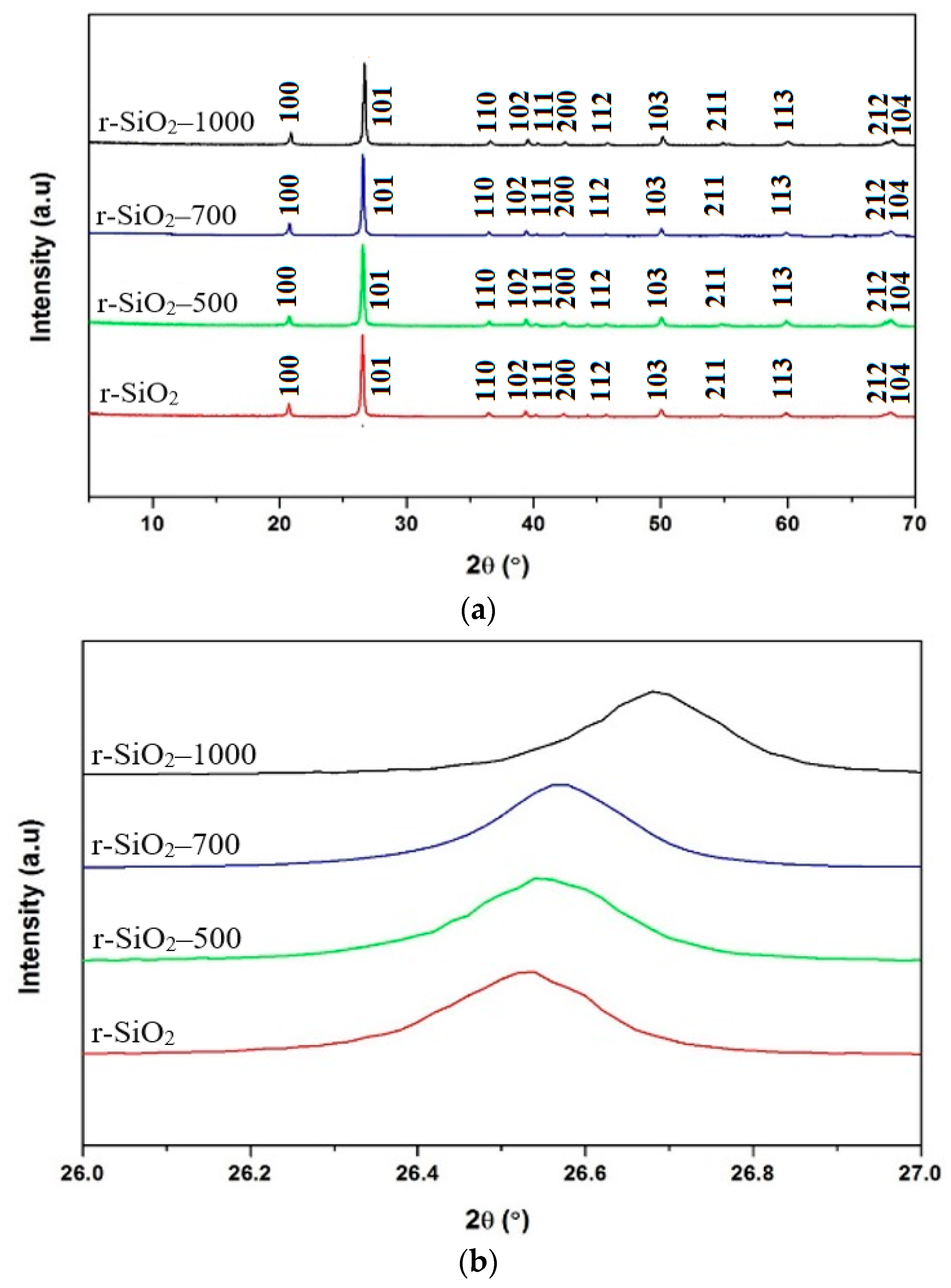
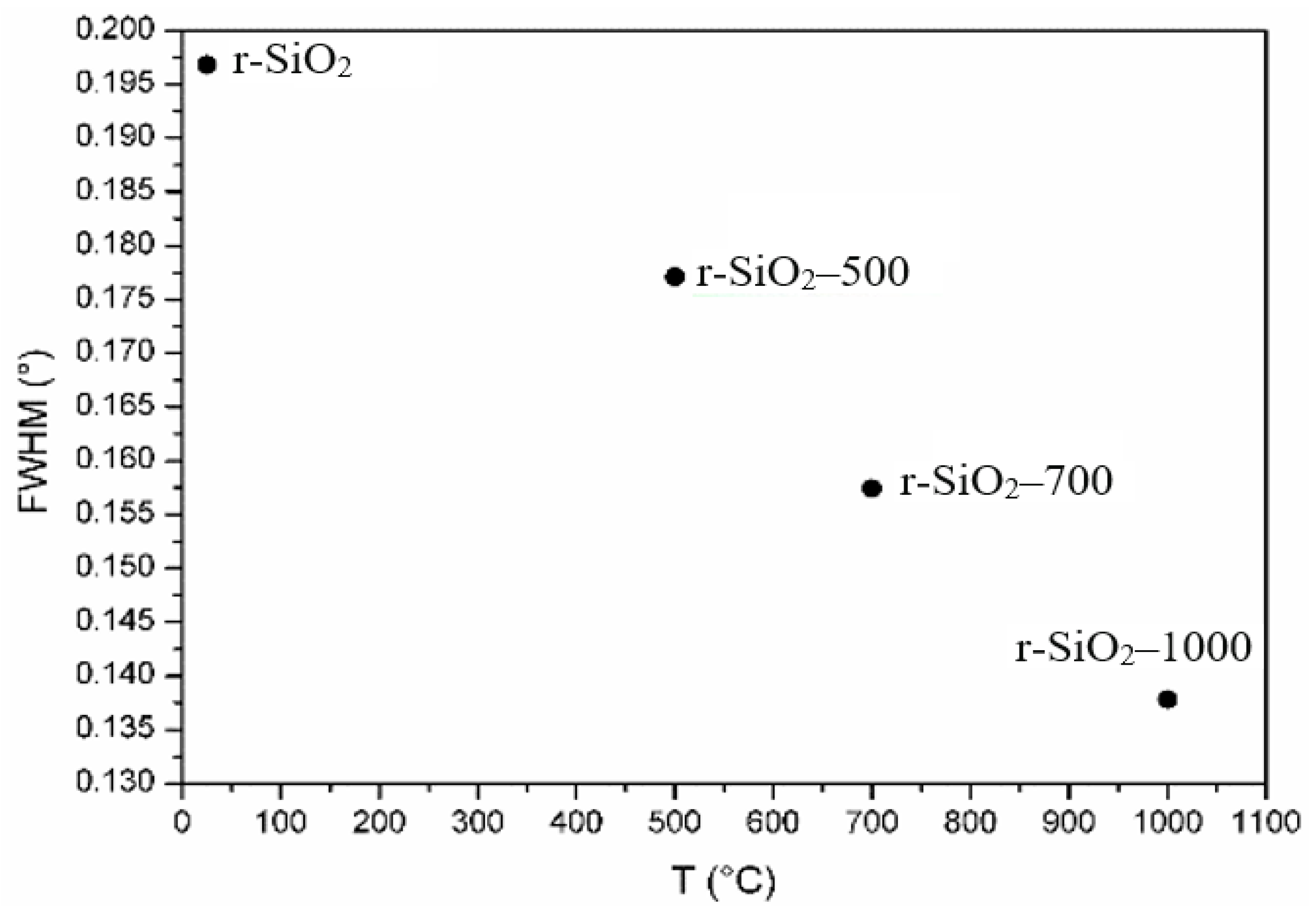
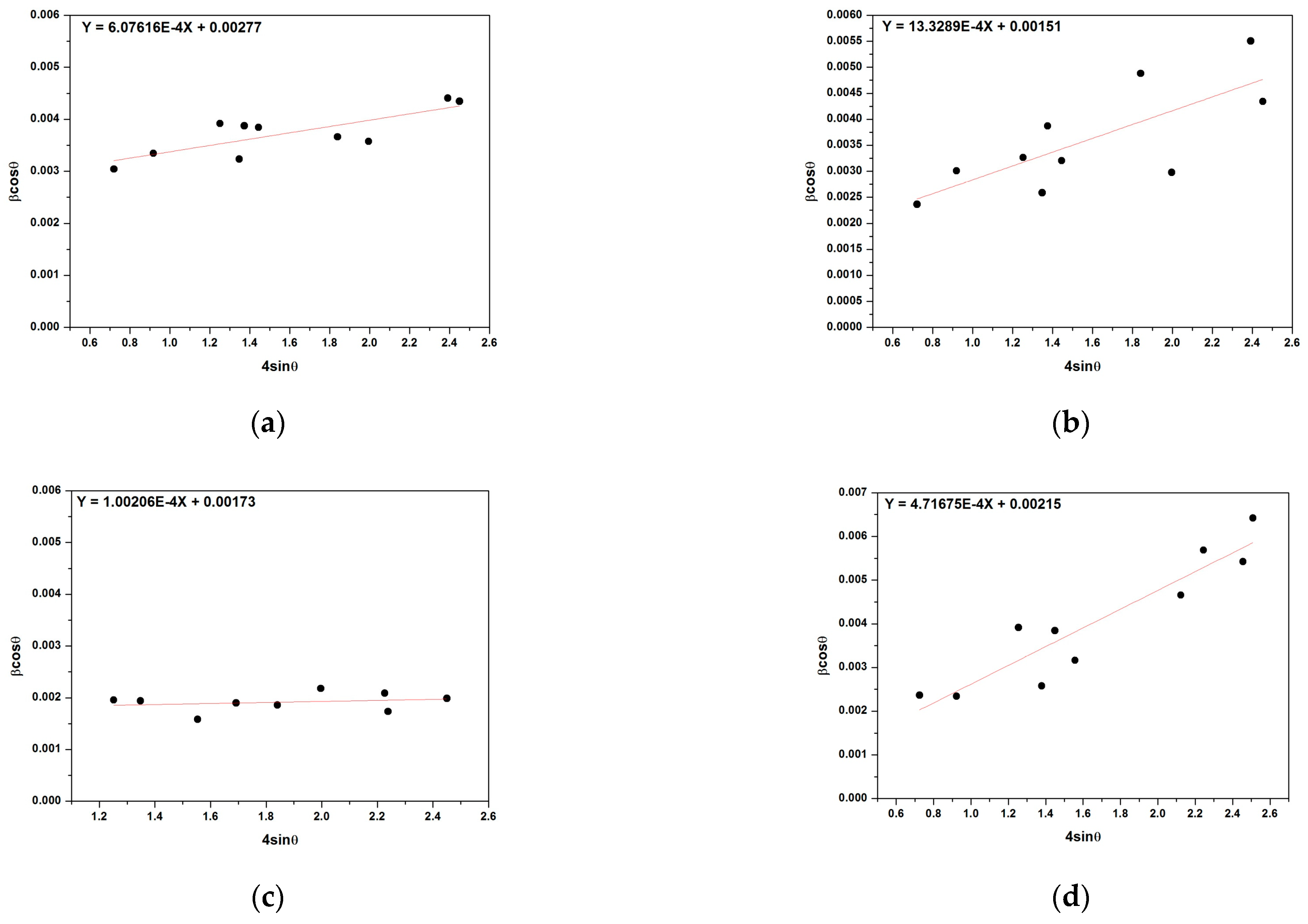
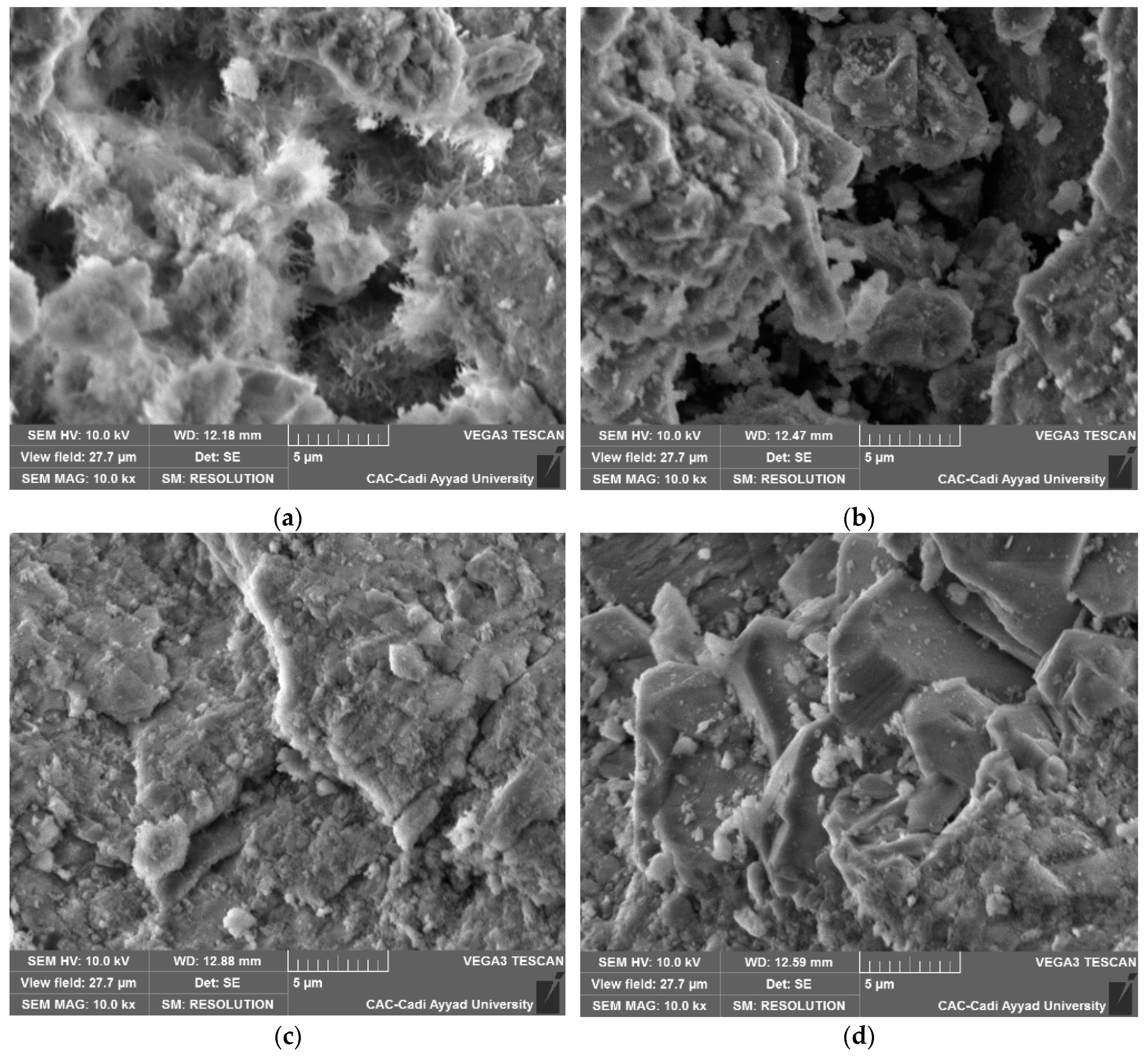

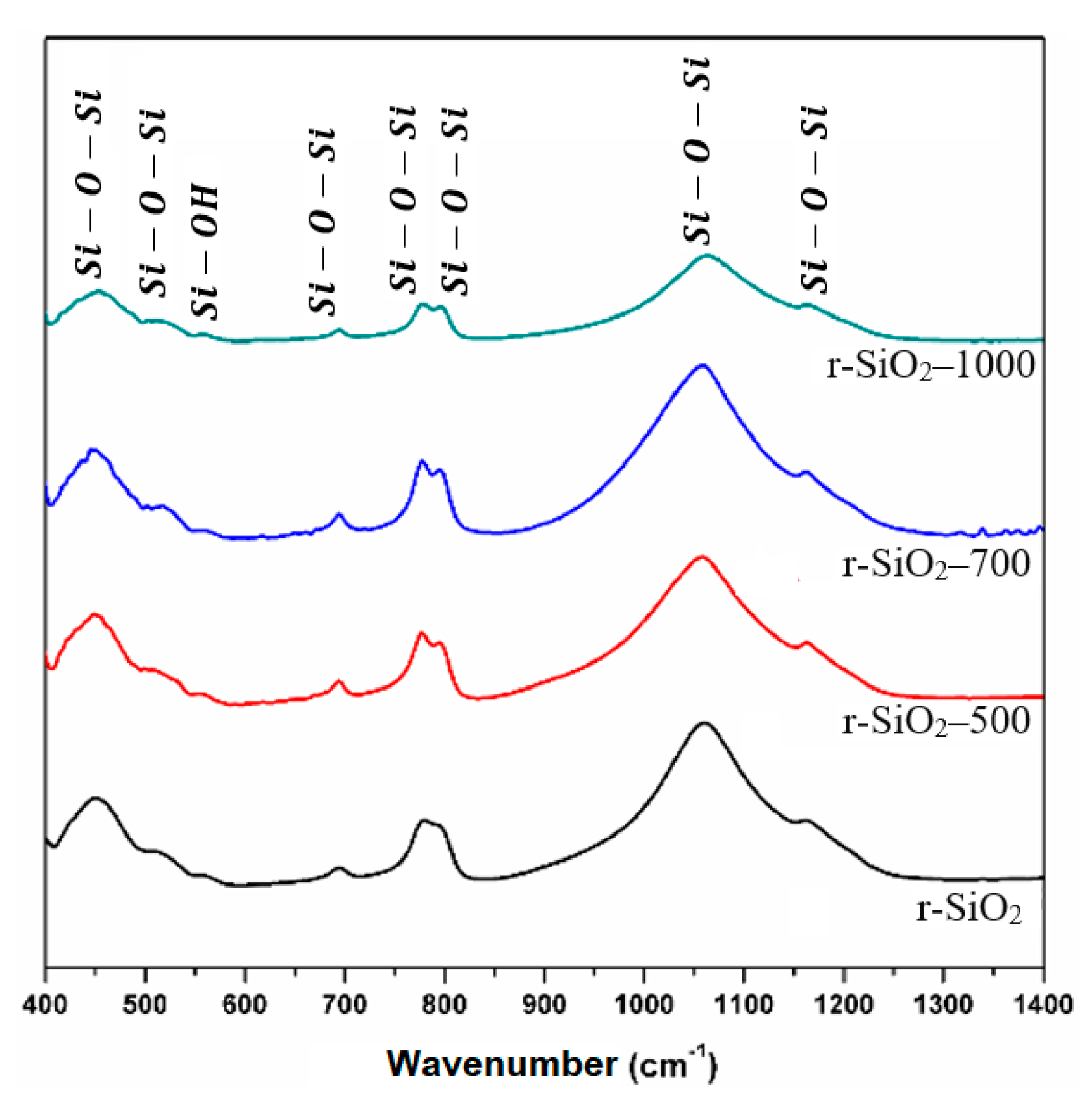
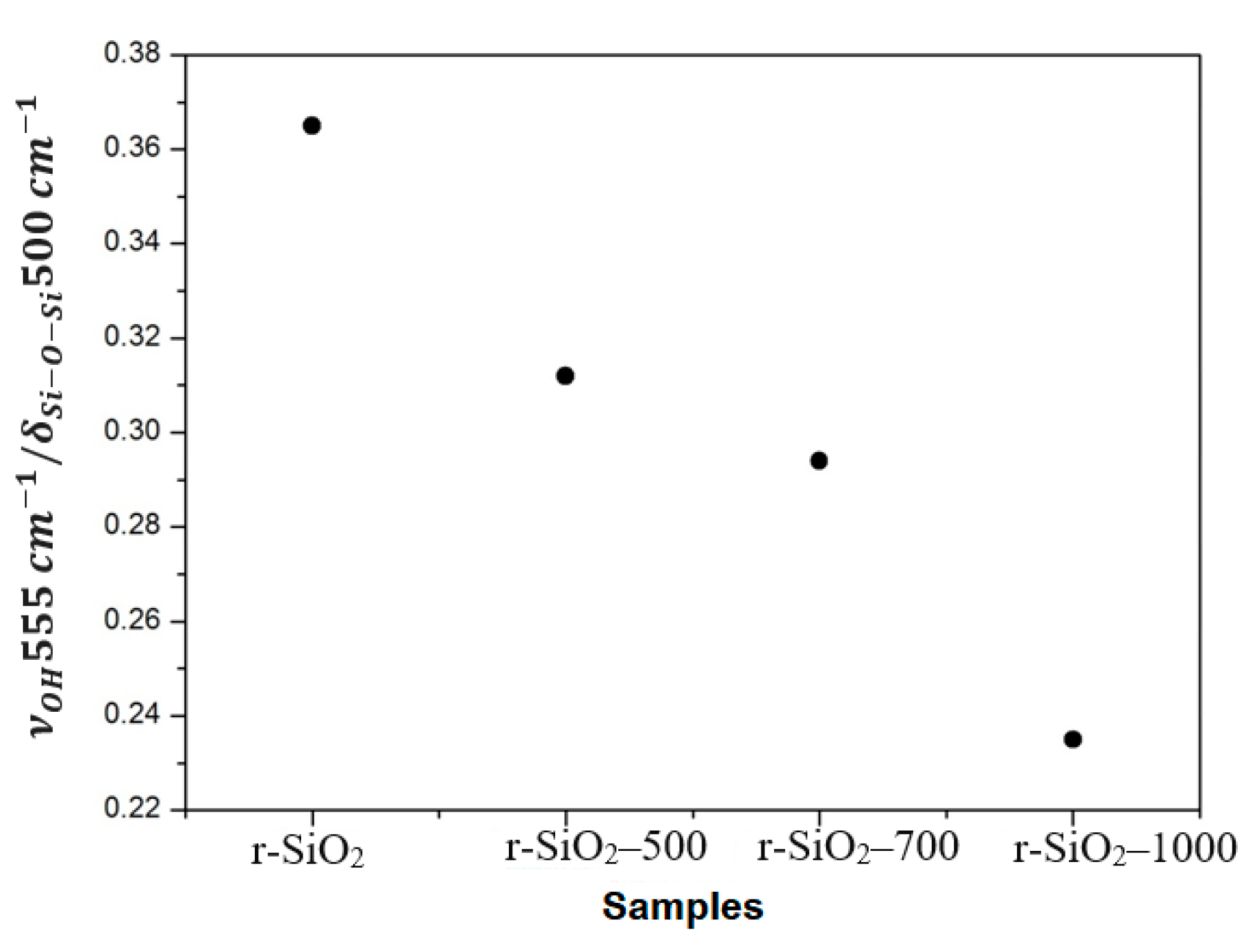
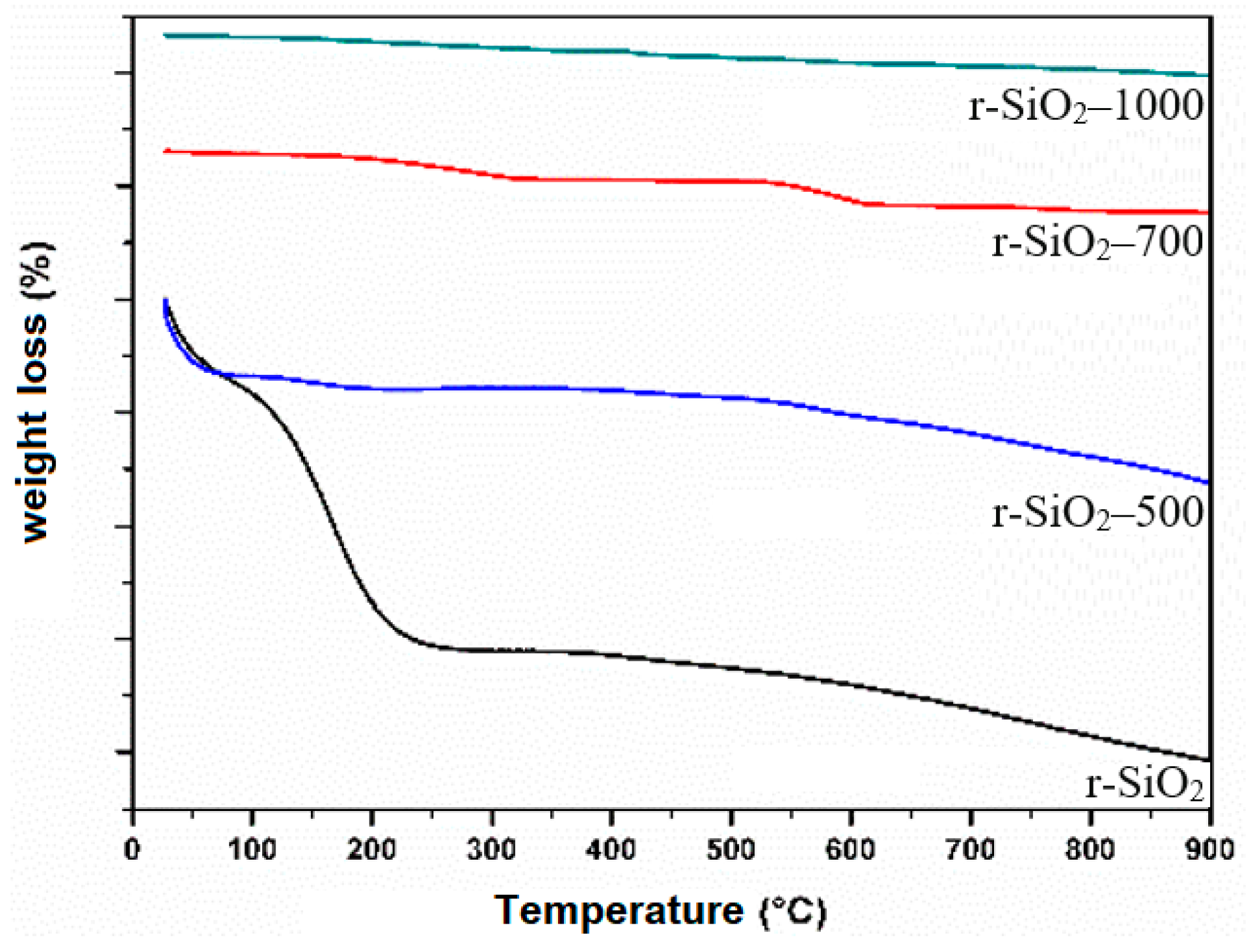
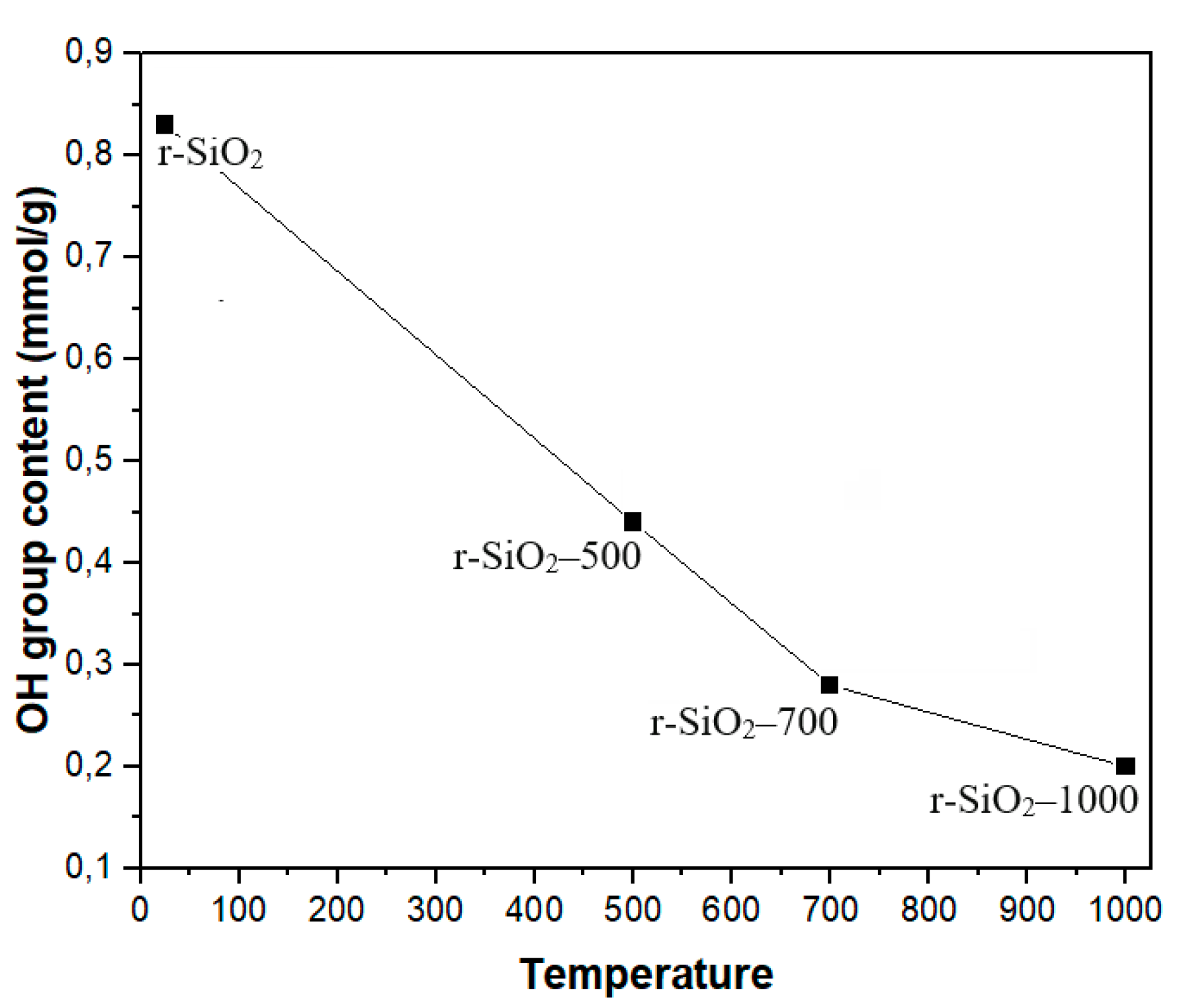
| Sample | Description |
|---|---|
| r-SiO2 | Unheated flint |
| r-SiO2–500 | Heat treated flint at 500 °C |
| r-SiO2–700 | Heat treated flint at 700 °C |
| r-SiO2–1000 | Heat treated flint at 1000 °C |
| Temperature (°C) | 2θ° | FWHM | Lattice Parameter | Crystallite Size (nm) | ||
|---|---|---|---|---|---|---|
| a = b (Å) | c (Å) | V (Å3) | ||||
| Flint unheated | 26.5277 | 0.1968 | 4.92937 ± 0.00009 | 5.47361 ± 0.00018 | 115.1829 ± 0.0048 | 41 |
| 500 | 26.5463 | 0.1771 | 4.69494 ± 0.00015 | 5.47950 ± 0.00028 | 104.6002 ± 0.0065 | 46 |
| 700 | 26.5709 | 0.1574 | 4.69165 ± 0.00014 | 5.47826 ± 0.00028 | 104.4297 ± 0.0065 | 52 |
| 1000 | 26.6804 | 0.1378 | 4.42348 ± 0.00013 | 4.95383 ± 0.00023 | 83.9459 ± 0.0054 | 59 |
| Samples | Williamson-Hall Method | |
|---|---|---|
| Micro-Strain ε (arb. Unit) | Crystallite Size (nm) | |
| r-SiO2 | 13.3289 × 10−4 | 42 |
| r-SiO2–500 | 6.0761 × 10−4 | 50 |
| r-SiO2–700 | 4.7167 × 10−4 | 64 |
| r-SiO2–1000 | 1.0021 × 10−4 | 80 |
| Sample | Mass Loss | OH Group Content (mmol/g) |
|---|---|---|
| r-SiO2 | 0.75 | 0.83 |
| r-SiO2–500 | 0.40 | 0.44 |
| r-SiO2–700 | 0.25 | 0.28 |
| r-SiO2–1000 | 0.18 | 0.20 |
Disclaimer/Publisher’s Note: The statements, opinions and data contained in all publications are solely those of the individual author(s) and contributor(s) and not of MDPI and/or the editor(s). MDPI and/or the editor(s) disclaim responsibility for any injury to people or property resulting from any ideas, methods, instructions or products referred to in the content. |
© 2023 by the authors. Licensee MDPI, Basel, Switzerland. This article is an open access article distributed under the terms and conditions of the Creative Commons Attribution (CC BY) license (https://creativecommons.org/licenses/by/4.0/).
Share and Cite
Oufakir, A.; Khouchaf, L. Structural and Surface Changes of SiO2 Flint Aggregates under Thermal Treatment for Potential Valorization. Crystals 2023, 13, 647. https://doi.org/10.3390/cryst13040647
Oufakir A, Khouchaf L. Structural and Surface Changes of SiO2 Flint Aggregates under Thermal Treatment for Potential Valorization. Crystals. 2023; 13(4):647. https://doi.org/10.3390/cryst13040647
Chicago/Turabian StyleOufakir, Abdelhamid, and Lahcen Khouchaf. 2023. "Structural and Surface Changes of SiO2 Flint Aggregates under Thermal Treatment for Potential Valorization" Crystals 13, no. 4: 647. https://doi.org/10.3390/cryst13040647
APA StyleOufakir, A., & Khouchaf, L. (2023). Structural and Surface Changes of SiO2 Flint Aggregates under Thermal Treatment for Potential Valorization. Crystals, 13(4), 647. https://doi.org/10.3390/cryst13040647





